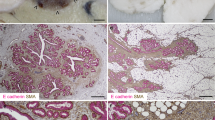Abstract
The lactating mammary gland of the African elephant (Loxodonta africana) has been studied with a panel of morphological techniques focusing on (1) the functional changes during the secretory process, (2) proliferative process [by application of proliferating cell nuclear antigen (PCNA) immunohistochemistry] and apoptotic phenomena [by use of the TUNEL technique] in the individual lobules, and (3) components of milk and milk-fat-globule membrane. In the lactating gland, the lobules are variably differentiated; within a lobule, however, the alveoli are usually similarly differentiated. The morphology of their alveoli suggests a classification of the lobules into types 1–3. Lobules of type 1 are composed of immature tubular alveoli with mitotic figures and numerous PCNA-positive nuclei; advanced type 1 alveoli contain abundant glycogen and specific secretory granules. Lobules of type 2 are further subdivided. In type 2a lobules, the epithelial cells of the alveoli form tall apical protrusions, which in part are occupied by small lipid droplets and which are pinched off in an apocrine fashion. The number of lysosomes varies considerably. Type 2b is the most common type, with striking basal membrane foldings, abundant rough endoplasmic reticulum cisterns, large Golgi apparatus, numerous mitochondria, lipid droplets, and protein vesicles with 30- to 90-nm-wide casein micelles. The lipid droplets are pinched off with minimal amounts of cytoplasm. Type 2c is composed of alveoli with a cuboidal epithelium and few signs of secretory activity. Increasing expression of peanut-agglutinin-binding sites parallels the maturation and differentiation of the glandular cells. Type 3 lobules are marked by numerous TUNEL-positive nuclei and large lipid droplets and are apparently degenerating structures. Cytokeratin (CK) 14 is usually present in the myoepithelial cells; CK 19 and CK 7 mark ductal and immature alveolar epithelia. Milk protein content varies between 2.6% and 6.3%, and casein micelles range from 35 to 90 nm in diameter. The diameter of intra-alveolar milk fat globules ranges from 5 to 25 µm and the membranes bear a filamentous surface coat composed of membrane-anchored mucins; gel-electrophoretic analysis of these mucins from different individuals demonstrates the presence of mucin MUC 1, which is expressed with considerable genetic heterogeneity.
Similar content being viewed by others
Author information
Authors and Affiliations
Additional information
Received: 22 May 1998 / Accepted: 13 July 1998
Rights and permissions
About this article
Cite this article
Welsch, U., Feuerhake, F., van Aarde, R. et al. Histo- and cytophysiology of the lactating mammary gland of the African elephant (Loxodonta africana) . Cell Tissue Res 294, 485–501 (1998). https://doi.org/10.1007/s004410051200
Issue Date:
DOI: https://doi.org/10.1007/s004410051200




